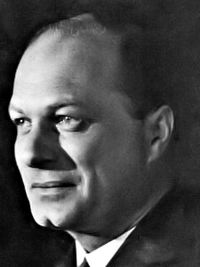Kay Fisker facts for kids
Quick facts for kids
Kay Fisker
|
|
|---|---|
 |
|
| Born | 14 February 1893 Frederiksberg, Denmark
|
| Died | 21 June 1965 (aged 72) Copenhagen, Denmark
|
| Nationality | Danish |
| Occupation | Architect |
| Awards | C. F. Hansen Medal (1947) Heinrich Tessenow Medal (1964) |
| Buildings | Aarhus University |
Kay Otto Fisker (born February 14, 1893 – died June 21, 1965) was a famous Danish architect, designer, and teacher. He is best known for designing many homes, especially in the Copenhagen area. He was a key figure in a style called Danish Functionalism, which focused on making buildings practical and useful.
Contents
Early Life and Training
Kay Fisker was born on February 14, 1893, in Frederiksberg, a part of Copenhagen, Denmark. He started studying at the Royal Danish Academy of Fine Arts in 1909. While he was a student, he also worked for some of the top architects in Scandinavia. These architects included Anthon Rosen, Sigurd Lewerentz, Gunnar Asplund, and Hack Kampmann.
In 1915, Kay Fisker and Aage Rafn won a competition. They designed the railway stations for the Almindingen-Gudhjem railway on the Danish island of Bornholm.
Designing Buildings
After finishing his studies, Kay Fisker spent most of his career designing homes. He created many important housing projects.
One of his key projects was the Aarhus University (built from 1931 to 1943). He designed it with C. F. Møller, Povl Stegmann, and Carl Theodor Marius Sørensen. This university is seen as one of the best examples of Danish Functionalism.
Another important building was Vestersøhus, built between 1935 and 1939. Fisker designed it with C. F. Møller. This building quickly became a model in Denmark for apartment blocks with balconies and bay windows. Kay Fisker also designed the Danish Academy in Rome, Italy.
Teaching and Influence
From 1936 to 1963, Fisker was a professor at the Royal Academy. He taught a special class on housing design. He was known as an inspiring teacher. He had a big impact on how homes were designed in Denmark.
He also visited the Massachusetts Institute of Technology in the United States. He was a visiting professor there in 1953 and 1957.
Key Buildings Designed by Kay Fisker
- Railway stations on Bornholm (1915)
- Hornbækhus housing in Copenhagen (1922)
- Aarhus University in Aarhus (1932–1943)
- Vester Søhus housing in Copenhagen (with C. F. Møller, 1935–1939)
- Dronningegården housing in Copenhagen (with Eske Kristensen, 1943–1958)
- Voldparken housing in Copenhagen (with others, 1945–1951)
- Danish Academy in Rome, Italy (1963–1965)
Awards and Recognition
Kay Fisker received several important awards for his work:
- 1926: Eckersberg Medal
- 1947: C. F. Hansen Medal
- 1958: Prince Eugen Medal for architecture
- 1964: Heinrich Tessenow Medal
Images for kids
See also
 In Spanish: Kay Fisker para niños
In Spanish: Kay Fisker para niños










